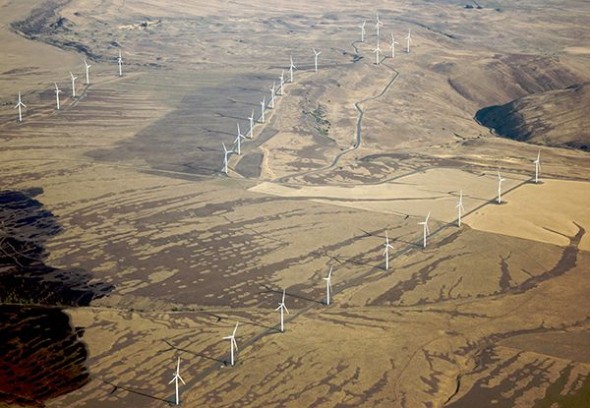PGE Resource Plan is a Win for Consumers
Posted on August 11, 2017 by Bob Jenks
Tags, Energy

The Oregon Public Utility Commission (OPUC) spent most of the day on Tuesday, August 8, considering PGE’s latest resource plan. OPUC acknowledged new investments in energy efficiency and demand response which PGE had demonstrated were cost effective. With Boardman closing down in 2020, OPUC recognized PGE’s need to replace part of Boardman’s output and acknowledged PGE’s efforts to secure contracts for hydro power to replace Boardman capacity. OPUC did not acknowledge PGE’s request to consider long term resources, likely powered by natural gas, if the hydro contracts are not secured. And OPUC did not acknowledge PGE’s request to open a Request for Proposals (RFP) to consider new renewable projects which would be considered alongside PGE’s proposal to build a new wind facility in the Columbia Gorge. OPUC did invite PGE to come back with a different proposal for renewable acquisition, but stressed that the current proposal was too risky for customers.
CUB was encouraged by the Commission decision, which largely follows CUB’s recommendation. In addition, several months ago, CUB called for PGE to pursue contracts from existing hydro facilities instead of trying to build new gas plants. It is good to see PGE embrace that strategy and to hear that it is likely to be successful.
A utility’s resource plan, or IRP, is a plan for how to meet its customer requirements. The focus is on the resource actions that the utility will take over the next five years and how those resource decisions will affect the utility’s costs over the next 20 years. OPUC does not approve or reject resource actions; it acknowledges them or does not acknowledge them. Acknowledgement means that based on the analysis of the utility, the resource decision seems reasonable. But the utility is expected to update its analysis as it gets closer to actually making the investment. Ultimately, when the utility asks ratepayers to pay for a resource, the utility will have to prove that the investment was prudently incurred.
CUB was concerned with PGE’s proposed IRP. Essentially, PGE had two resource plans. The first was to meet PGE’s load as it replaced Boardman, and the second was to comply with Oregon’s renewable portfolio standard (RPS). As originally filed, it looked like PGE’s goal was to replace Boardman with two new gas fired plants and to build a new wind farm in order to comply with RPS requirements after 2028 – but PGE already has sufficient renewable resources to comply with the RPS until 2028.
CUB’s biggest concern was the new gas plants. PGE brought a new gas plant online last year that had a 45-year useful life. This means that PGE is expecting to serve natural gas to customers past 2060. Knowing that climate change will continue to require utilities to reduce carbon emissions, CUB deemed it irresponsible to be adding this much long-term gas capacity. Instead, CUB argued that PGE should seek shorter term contracts for available hydro power. With the uncertainty that hangs over the electric industry due to climate change and technological change, there is value in finding shorter term resources rather than investing customer money in projects that need to last 30 to 45 years to recover their initial capital investment.
CUB was not the only entity that opposed the new gas plants. Sierra Club and several environmental and climate organizations also called for rejection of these power plants. In addition, there was an overflow crowd of PGE customers at a May public meeting asking the Commission to reject the gas plants.
To its credit, PGE recognized the opposition to the gas plants and began seeking hydro contracts as a better alternative. By not acknowledging the gas plants (or gas plant RFP) as a back-up to the hydro contracts, OPUC made it unlikely that those gas plants will ever be built.
CUB was also supportive of OPUC not offering an acknowledgement of the new wind project, but rather inviting PGE to come back with a different renewable acquisition plan. PGE already has a great deal of Gorge wind. It is a good renewable resource. But the key to renewables is diversity. Last week, when the temperatures topped 100°F, PGE customers set a record for energy usage. But the weather conditions also meant there was almost no wind in the Gorge. Having an additional wind project located near PGE’s existing ones would not have helped meet last week’s record load.
In addition, PGE is expected to be in compliance with the RPS through at least 2028. This means that current customers are being asked to pay for a project that doesn’t provide a lot of current benefit in meeting load and won’t be needed for compliance for more than a decade.
It is time for PGE to begin looking beyond Gorge wind as a renewable energy source. It needs to diversify by adding utility-scale solar, developing wind in other wind corridors, or developing new creative projects that combine renewables and storage.
As PGE plans for a carbon constrained world, it needs to avoid new long-term fossil fuel power plants and it needs to invest wisely in renewable projects.
CUB believes that this IRP process yielded a good outcome for ratepayers. Rather than pursuing new gas plants, PGE is looking to replace Boardman with contracts from existing hydro facilities. And, rather than build a renewable project that offers little value to customers, PGE is getting the message that it needs to find ways to bring more value to customers from renewable investments.
To keep up with CUB, like us on Facebook and follow us on Twitter!




08/11/17 | 0 Comments | PGE Resource Plan is a Win for Consumers